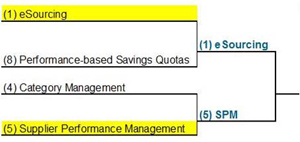What is the best CPO tool or strategy in 2012?
Our field of 32 determines this year’s champion
Yes folks, it’s March Madness, Chief Procurement Officer Style, where the different procurement tools and strategies compete to get to the CPO’s Final Four.
It’s on! The CPO Rising Tournament 2012 began yesterday in the First Region with the first four CPO Tools vying for a ticket to the Sweet Sixteen. And already, we have seen our first (slight) upset as well as one big blow out. The early indications are that this tournament is wide open. Yes, there are favorites – the tried and true tools – but in the procurement realm, the diversity of challenges and interactions seen on a daily basis makes it anyone’s guess how this will all shake out.
Speaking of guesses, more than 40 fans downloaded the empty bracket, but only a handful completed and submitted them by our deadline. A small field, but one that is no less competitive – good luck to those true players!
We assume that many of you decided to play along at home – which is absolutely fine ( for those that want to keep score, here is the original bracket – we will provide updated brackets at this link throughout the tourney.
Let the games begin!
Region One: (1) eSourcing vs. (8) Performance-based Savings Quotas
Our first match pits the dynamic powerhouse, eSourcing versus the scrappy upstart, Performance-based Savings Quotas (“PbSQ”). eSourcing jumped out to a quick lead as a long-standing solution that is understood (if not adopted) by most procurement departments. Deployed in the cloud or behind a firewall and priced aggressively in the market, eSourcing continued to play on all cylinders. The sold-out crowd cheered as its linkage to the other strategic sourcing processes and applications proved that eSourcing can play as a team (of solutions) or go it alone (as it is often forced to do) in driving savings for sourcing teams.
Performance-based Savings Quotas, perhaps feeling just lucky to get to the “big dance” (as they say, “qualifying for the tournament, was their tournament”), never got into a natural rhythm and flow of the game – tripping over itself in the early stages as it became confused as to whether or not it could reasonably be implemented and what percentage commission is right to pay on a multi-million dollar save. At halftime, it’s coach was heard screaming – “are we seriously suggesting paying bonuses that are directly linked to savings or are we just a concept trying to prove that procurement can be a modern department.”
Inspired by their coach, PbSQ came out strong in the second half, tackling the issue of savings head-on and using its existence as a way to force enterprises that use it to define savings in an unambiguous way. Hustling the entire time, PbSQ made a last run at eSourcing using the fact that it can sometimes help procurement and the larger organization understand the relative importance of savings versus other business factors. But it was for naught as PbSQ ultimately tripped itself up in a flurry of ambiguity that often exists around (1) the definition of savings and (2) a procurement staffer’s ultimate impact on savings (versus market forces, etc.) as well as (3) an impracticality of using this tool in many different environments which ensures that it will not be widely adopted by the industry.
Once eSourcing rolled out its ability to use templates and historical events to create new ones, the rout was on. Price Discovery driven by Reverse Auctions played the entire game and was player of the game, leaving its “bench” of other capabilities very well rested for the next game
Region One – (4) Category Management vs. (5) Supplier Performance Management
The four seed v. five seed games are usually the most competitive and most entertaining. And our match between Category Management and Supplier Performance Management (“SPM”) did not disappoint.
Category Management caught fire to start the game with its common-sense grounding in the idea that “different things need to be managed, you know, differently” and roared to a huge lead. Its broad applicability to all categories of mention and its way to formalize the activities, processes, and reporting of category managers made it seem like we were in for a very one-sided game….. That is, until SPM gained its footing and remembered that in the public discourse over the past seven years, it is almost always the most desired solution for CPOs to begin using in the next year.
Category Management immediately fired back with an argument that the gap between the public preferences of CPOs for SPM and their investment in it was often quite large.
With a few minutes to go, it was still either tool’s game for the taking.
CM battered the boards with its comprehensive lifecycle approach and the impact it has had on standardization of processes (and in many instances, the standardization of category requirements) across global organizations.
But SPM stayed focused and played within itself, knowing that it is often the procurement department’s first (and frequently) only acknowledgement that a focus on suppliers is important. And, while this has created a false sense of comfort among some CPOs, SPM has also been known to swing an eSourcing deal or two in its day.
As time ran out, CM hurled a final claim that the term “Cat Strat” was one of the few cool terms to emerge from procurement over the past few years but that shot clanged in and out and when the fans looked up SPM had won.
Tagged in: Chief Procurement Officer, CPO, CPO Bracketology, CPO Shop Talk, Events









